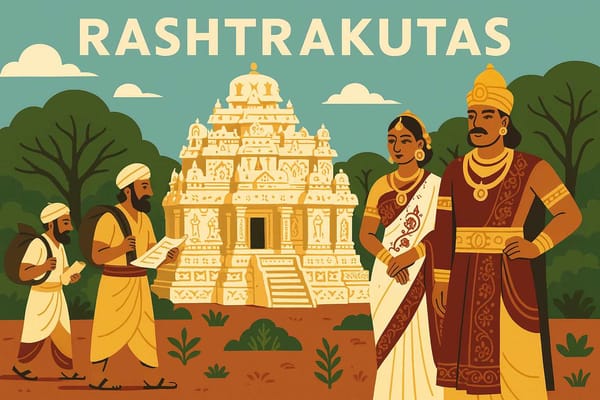
The Rashtrakutas-Explore Their Historical Era
Have you ever stood before a mountain, not just looking at it, but seeing a temple carved out of its very soul? Imagine engineers and artists, centuries ago, chipping away at a single, massive rock, not to build something upon it, but to reveal a divine chariot hidden within. This isn't a fantasy; this is the breathtaking reality of the Kailasa Temple at Ellora, a gift to the world from one of India’s most formidable yet often overlooked dynasties – the Rashtrakutas.
Their story isn't just about conquests and kingdoms; it's a chapter of our history filled with unparalleled artistic vision, administrative genius, and a deep cultural soul. Let’s journey back in time, to the heart of the Deccan, to rediscover the golden era of the Rashtrakutas.
The Dawn of an Empire: From Chieftains to Emperors
The very name 'Rashtrakuta' tells a story. In Sanskrit, 'Rashtra' means country or region, and 'Kuta' means chieftain. They started as chieftains, serving other great powers, but destiny had a grander plan. In the middle of the 8th century, a charismatic and ambitious leader named Dantidurga rose to prominence. He did the unthinkable – he challenged and overthrew his masters, the powerful Chalukyas of Badami, in 753 AD. This wasn't just a victory; it was the birth of a new empire that would dominate India for over two centuries.
From their capital at Manyakheta (near modern-day Kalaburagi in Karnataka), the Rashtrakutas established a realm that was vast and efficiently governed. Their administrative system was a marvel, with the empire divided into provinces known as 'Rashtras' and districts called 'Visayas'. This structure ensured that even the farthest corners of their sprawling kingdom were managed effectively, allowing peace and prosperity to flourish.
Masters of War and Governance
The Rashtrakutas were not just rulers of the Deccan. At their zenith, their influence stretched from the fertile plains of the Ganga and Yamuna in the north down to the southern tip of India. They were a true pan-Indian power, a force to be reckoned with.
- Military Might: The Rashtrakuta army was legendary. Rulers like Dhruva Dharavarsha, Govinda III, and Indra III were brilliant military strategists who led successful campaigns against other major powers of the time, including the Pratiharas of Western India and the Palas of Bengal. Imagine the sheer power it took to capture a city like Kannauj, the heart of North Indian politics, which Indra III accomplished, solidifying Rashtrakuta supremacy.
- A Flourishing Kingdom: Their strength wasn't just in their army. The Rashtrakuta kings understood that a happy kingdom is a strong kingdom. They built a society that was well-administered, prosperous, and culturally vibrant. Their patronage of trade brought wealth, while their efficient governance ensured stability, allowing art and literature to reach new heights.
Where Stone Breathes: A Legacy of Art and Architecture
If you want to witness the soul of the Rashtrakuta dynasty, you must go to the Ellora Caves. Here, they commissioned the creation of the magnificent Kailasa Temple (Cave 16). This is not a structure built brick by brick; it is a monolithic wonder, carved top-down from a single piece of basalt rock. It stands as a timeless testament to their devotion, ambition, and the sheer genius of their artisans. It’s an architectural marvel that continues to baffle engineers and enchant visitors today.
This unique architectural style, a blend of Dravidian and local Deccan influences, is now celebrated as the Karnata Dravida style. These sacred spaces weren't just places of worship; they were centres of community, art, and learning. Exploring such historical marvels helps us connect with the spiritual roots of our land, a journey of discovery that we at Bhaktilipi are passionate about facilitating. If these stories of devotion etched in stone move you, you’ll find a similar spirit in the timeless devotional literature we curate on Bhaktilipi.in.
The Soul of the Kingdom: Culture, Language, and Faith
The Rashtrakuta court was a vibrant hub of intellectual and cultural activity. They were great patrons of literature, and under their rule, both Sanskrit and Kannada languages flourished. One of the most remarkable rulers of this dynasty was Amoghavarsha I. He was not just a conqueror but also a profound scholar and poet himself. Often called the 'Ashoka of the South' for his peaceful temperament and patronage of arts, his reign is considered a golden age for Kannada literature. He created a kingdom where poets and scholars were as revered as warriors.
What truly set the Rashtrakutas apart was their spirit of religious tolerance. While many kings were devout Hindus, particularly Shaivites, they provided immense support to Jainism and Buddhism. In fact, Jainism saw a significant rise in influence during their time, with Amoghavarsha I being a devout follower. This created a harmonious society where different faiths could coexist and enrich each other, a lesson that remains incredibly relevant today.
Unravelling the Rashtrakuta Era: Your Questions Answered
So, when we try to understand the Rashtrakutas, we see they were far more than just a medieval dynasty that ruled large parts of India between the 6th and 10th centuries. They were architects of culture, formidable warriors, and wise administrators who connected North and South India. Their most profound achievements, from the architectural marvel of the Kailasa Temple to their rich contributions to Kannada literature, have left an indelible mark on our history.
The decline of their empire in the late 10th century, caused by internal conflicts and the rise of rival powers, marked the end of an era. Yet, their legacy endures. By learning about the Rashtrakutas, we don't just study history; we connect with a time of immense creativity, power, and cultural prosperity that continues to shape India's magnificent heritage.
Explore Our Rich Heritage with Bhaktilipi
Stories like that of the Rashtrakutas are the bedrock of our culture. At Bhaktilipi, we are dedicated to preserving and sharing these timeless tales and devotional literature. We believe that understanding our past is a form of devotion in itself—a way to honour the traditions that have shaped us.
Dive deeper into India's spiritual and historical legacy with us. Subscribe to our newsletter for more inspiring stories and follow us on Facebook, Instagram, and YouTube for a daily dose of devotion and heritage.
A passionate group of people dedicated to preserving India's knowledge of Dharma, Karma, and Bhakti for ourselves and the world 🙏.
Comments
Related in

Rashtrakutas: History and Impact Explained
Sometimes, when we look back into the pages of our history, we find stories so grand, so magnificent, that they feel almost like a dream. The story of the Rashtrakuta dynasty is one such tale. It’s not just a chapter in a history book; it's a living,

Rashtrakutas- Explore a Historical Dynasty
Have you ever stood before an ancient temple and felt the stories of centuries wash over you? In the grand tapestry of Indian history, some threads shine brighter than others, and one of the most vibrant is the story of the Rashtrakutas. This isn't just a tale of
